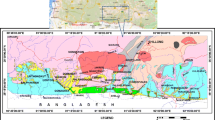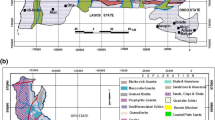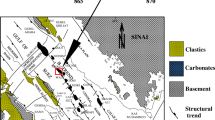Abstract
This paper presents new data on natural environmental radiation mapping in Meghalaya for the first time in India. Two alternate methods have been used to map (1) a regional low-density environmental radiation mapping by using radiation meters, (2) high-resolution radiation mapping of Shillong Basin using the data generated by an integrated litho- and pedo-geochemical sampling program using gamma ray spectrometric measurements on both rock and soils samples. The variation in radio-elemental concentrations and radiation levels are related to bedrock geology and structures. The high levels of radiation levels are observed in the areas occupied by Mylliem Granite (3.935 mSv/a, 51 μR/h, 178.066 nGy/s) followed by South Khasi Batholith with pink feldspar (2.42 to 3.652 mSv/a, 31 μR/h, 109.502–165.249 nGy/s), graphitic schists (avg. 52.10 pGy/s, 1.06 mSv/a), Chlorite Schist (avg. 51.16 pGy/s, 1.13 mSv/a), Phyllites (avg. 47.98 pGy/s, 1.06 mSv/a), volcanics (avg. 46.9 pGy/s, 1.04 mSv/a), The Chlorite schist of Tyrsad formation (21 μR/h, 1.643 mSv/a, 74.321 nGy/s) and Barapani arenite (16 μR/h 1.21 mSv/a, 54.773 nGy/s), Tertiary sandstone (21 μR/h, 1.633 mSv/a, 73.885 nGy/s), Shella subgroup (12 μR/h, 0.914 mSv/a, 41.376 nGy/s), Langpars (13 μR/h, 1.006 mSv/a, 45.502 nGy/s), Upper Mahadek (26 μR/h, 2.062 mSv/a, 93.298 nGy/s), Lower Mahadek (38 μR/h, 2.935 mSv/a, 132.785 nGy/s), and the lowest environmental radiation levels are observed over Sylhet traps (9 μR/h, 0.725 mSv/a, 32.786 nGy/s). The soils generally show higher radiation levels as compared to their bed rocks. Comparisons are made with high radiation areas of the world results, showing that they are lower than high background radiation areas. These radiation images are the first series of environmental images for Meghalaya and will serve as the baseline data for the upcoming uranium mining projects in Meghalaya. Baseline environmental radiation images are necessary information to policy makers and provide a sound basis for addressing the public concerns for radiation levels.








Similar content being viewed by others
References
Abdel Hady EE, El-Sayed AMA, Ahmed AA, Hussein AZ (1994) Natural radioactivity of basement younger granite rocks from the eastern desert. Radiat Phys Chem 44(1/2):223–224
Atomic Energy Regulatory Board (AERB) (2017) Prescribed dose limits of radiation for occupational workers and common public. https://www.aerb.gov.in/english/radiation-protection-principle. Accessed 04 Dec 2019
Ali MA, Desapati T, Deshmukh RD (2001) Heavy minerals resources in the beach placers of Maharashtra. Special issue on beach and inland heavy minerals sand deposits of India, Dhanaraju, R., Ali, M. A., and Krishan, S., (Editors). Explor Res At Miner 13:147–155
Al-Jundi J (2002) Population doses from terrestrial gamma exposure in areas near to old phosphate mine, Russaifa Jordon. Radiat Meas 35:23–28
Andersson PS, Wasserburge GJ, Chen JH, Papanastassiou DA, Ingri J (1995) 238U, 234U and Th in the Basaltic sea and river water. Earth Planet Sci Lett 130:217–234
Barooah BC, Goswami ID (1972) Precambrian stratigraphy of the Assam plateau. J Mines Met Fuels 20(12):368–373
Chandrashekharan S, Murugan C (2001) Heavy minerals in the beach and coastal Red Sands (Teris) of Tamilnadu. Special issue on beach and inland heavy minerals sand deposits of India, Dhanaraju, R., Ali, M. A., and Krishan, S., (Editors). Explor Res At Miner 13:87–109
Chimote J.S., Pandey B.K., Bagchi A.K., Basu A.N. and Saraswat A.C. (1988): Rb–Sr whole rock isochron age for the Mylliem granite. In: 4th national symposium on mass spectrometry, Bangalore
Choudhury JM, Ahmed M (1967) Sedimentological studies of the basal conglomerate (Sumer conglomerate) of the Shillong series near Barapani, K &J hills, Assam (abstract). In: Proceedings of Indian Science Congress, 54th session, pt. 3, p 248
Chougaonkar MP, Walling IM, Khan AH, Hoda SQ, Puranik VD (2004a) Preliminary results of the preoperational radiation survey carried out in the environs of Domiasiat, Meghalaya, India using TL dosimetric techniques. In: Proceedings of the thirteenth national symposium on environment, Shillong, India, pp 382–386
Chougaonkar MP, Eappen KP, Ramachandran TV, Shetty PG, Mayya YS, Sadasivan S, Venkat Raj V (2004) Profiles of doses to the population living in the high background radiation areas in Kerala, India. J Environ Radioact 71:275–297
Dasgupta HC (1934) On the Mylliem granite, Khasi Hills, Assam. Quart Geol Min Met Soc Ind VI(I):1–4
Devi NR, Sarma KP (2010) Strain analysis and stratigraphic status of Nongkhya, Sumer and Mawmaram conglomerates of Shillong basin, Meghalaya, India. J Earth Syst Sci 119(2):161–174
Dhurandhar AP, Pradhan AK (2004)Reconnaissance radiometric, Litho, Pedo and Hydrogeochemical surveys in parts of Shillong, Basin, Meghalaya, Unpublished annual report. Atomic Minerals Directorate, Hyderabad
Dhurandhar AP, Kumar P, Majumdar A, Umamaheswar K (2008) Spatial and temporal variability of hydrogeochemical patterns around Wahkyn uranium deposit, Meghalaya. J Appl Geochem 10:593–629
Dhurandhar AP, Umamaheswar K, Zakaulla S, Raminaidu C, Pandey UK (2010) Geochemistry and geochronology of basic dykes, Mikir Hills Assam, India. In: International Dyke conference (IDC-6) Varanasi, abstract, p 36
Durante M, Manti L (2008) Human response to high-background radiation environments on Earth and in space. Adv Space Res 42:999–1007
Duarah BP, Phukon S (2011) Understanding the tectonic behaviour of the Shillong Plateau, India using remote sensing data. J Geol Soc India 77:105–112
El-Shershaby A (2002) Study of radioactivity levels in granite of Gable Gattar II in the north eastern desert of Egypt. Appl Radiat Isot 57:131–135
Evans P (1932) Tertiary succession in Assam. Trans Min Geol Inst Ind 27:155
Evans P (1964) Tectonic framework of Assam. J Geol Soc India 5:80–96
Gajapathy Rao R, Sahoo P, Panda N (2001) Heavy mineral sand deposits of Orissa. Special issue on beach and inland heavy minerals sand deposits of India. In: Dhanaraju R, Ali MA, Krishan S (eds) Exploration and research for atomic minerals, vol 13. Atomic Minerals Directorate for Exploration and Research (AMD) Department of Atomic Energy (DAE) Hyderabad, India, pp 23–52
Ghose S, Chakraborty S, Paul DK, Bhalla JK, Bishui PK, Gupta SN (1994) A new Rb–Sr ages and geochemistry of granitoids from Meghalaya and their significance in middle to late Proterozoic crustal evolution. Ind Miner 48(1&2):33–44
Gogoi K (1973) Geology of the Precambrian rocks in Northwestern part of Khasi and Jaintia Hills, Meghalaya Geol. Surv India Misc Pub No 23:37–48
Grasty RL, Carson JM, Charbonneau BW, Holman PB (1984) Natural background radiation in Canada. Geol Surv Can Bull No 360:39
Hoda SQ (2004) Exploration for uranium in Meghalaya and the environmental monitoring strategies. In: Proceedings of the thirteenth national symposium on environment, Shillong, India, pp 33–43
Hostetler PB, Garrels RM (1962) Transportation and precipitation of uranium and vanadium at low temperature with special reference to sandstone-type uranium deposits. Econ Geol 57:137–167
International Atomic Energy Agency (1990) The use of gamma ray data to define the natural radiation environment, TECDOC No 566. IAEA, Vienna, pp 1–45
International Commission on Radiological Protection ICRP (2005) Protecting people against radiation exposure in the event of a radiological attack publication 96, 2005, p 51. https://www.remm.nlm.gov/ICRP_guidelines.htm. Accessed 04 Dec 2019
Kabata-Pendias A, Pendias H (2001) Trace elements in sols land plants, 3rd edn. CRC Press, Boston
Kannan V, Rajan MP, Iyengar MAR, Ramesh R (2002) Distribution of natural and anthropogenic radionuclides in soil and beach sand samples of Kalpakkam (India) using hyper pure germanium (HPGe) gamma ray spectrometry. Appl Radiat Isotopes 57:109–119
Khonglah MA, Khan MA, Karim MA, Kumar A, Choudhury J (2008) Geology and structure of the areas in and around Shillong, Meghalaya, North East India, revisited. In: Proceedings of the national seminar on geology and energy resources of NE India: progress and perspectives.Nagaland University Research Journal, Special Publication, pp 115–139
Kogan RM, Nazarov IM, Freidman SD (1971) Gamma spectrometry of natural environments and formations. Israel Programme for Scientific Translations, Jerusalem
Krishan S, Vishwanathan G, Balachandran K (2001) Heavy mineral sand deposits of Kerala. Special issue on beach and inland heavy minerals sand deposits of India, Dhanaraju, R., Ali, M. A., and Krishan, S., (Editors). Explor Res At Miner 13:111–146
Kumar P, Panigrahi B, Joshi GB (2016) Palaeochannel controlled cretaceous sandstone-type uranium deposit of Lostoin Area, Mahadek Basin, Meghalaya. J Geol Soc India 87:424–428
Langmuir D (1978) Uranium solution–mineral equilibria at low temperatures with applications to sedimentary ore deposits. Geochim Cosmochim Acta 42:547–570
Lemmelae H (1984) Ulkoisen Taustas/teilyn Kartoitus Suomessa. Raportti STUK-B-VALO 32S. Teilyturvakeskus (in Finish)
Lima A, Albanese S, Cicchella D (2005) Geochemical baseline for the radio elements K, U and Th in the Campania region, Italy: a comparison of stream-sediment geochemistry and gamma-ray surveys. Appl Geochem 20:611–625
Lovborg L (1984) The calibration of portable and airborne gamma ray spectrometer. Geological Survey of Canada, paper 76-16
Mallikharjuna RJ, Poornachandra Rao GVS, Sarma KP (2009) Precambrian Mafic Magmatism of Shillong Plateau, Meghalaya and their evolutionary history. J Geol Soc India 73:143–152
Mazumdar SK (1976) A summary of the Precambrian geology of the Khasi Hills, Meghalaya. Geol Surv Ind Misc Publ 23:311–334
Mazumdar SK (1986) The Precambrian framework of part of the Khasi hills, Meghalaya. Rec Geol Surv India 117(2):1–59
McKelvey VE, Everhart DL, Garrels RM (1955) Origin of uranium deposits: economic geology. In: 50th anniversary, pp 464–533
Medlicot HB (1869) Geological sketch of Shillong Plateau in NE. Bengal. Geol Surv India Mem 7:1
Mohanty AK, Sengupta D, Das SK, Saha SK, Van KV (2004) Natural radioactivity and radiation exposure in the high background area at Chhatrapur beach placer deposit of Orissa, India. J Environ Radioact 75:15–33
Mortazavi SMJ, Ghiassi Nejad M, Beitollahi M (2001) Very high background radiation areas (VHBRAs) of Ramsar: do we need any regulations to protect the inhabitants? In: Proceedings of the 34th midyear meeting, radiation safety and ALARA considerations for the 21st century, California, USA, pp 177–182
Nandi DR (2001) Geodynamics of Northeast India and adjoining regions. ACB Publications, Lake Town
Nash JT, Granger HG, Adams SS (1981) Geology and concepts of genesis of important types of uranium deposits. Economic geology 75th anniversary, pp 63–116
Obed RI, Farai IP, Jibri NN (2005) Population dose distribution due to soil radioactivity concentration levels in 18 cities across Nigeria. J Radiol Prot 25:305–312
Oldham T (1858) Geological structure of a portion of the Khasi Hills. Mem Geol Surv India 1:2
Osmond JK, Ivanovich M (1992) Uranium series mobilization and surface hydrology. In: Ivanovich M, Harmon RS (eds) Uranium series disequilibrium; applications to earth, marine and environmental sciences. Clarendon Press, Oxford, pp 259–289
Palmer RW (1924) Geology of a part of the Khasi and Jaintia Hills, Assam. Rec Geol Surv India 55:2
Paul AC, Pillai PMB, Haridasan P, Radhakrishnan S, Krishnamony S (1998) Population exposure to airborne thorium at the high natural radiation areas in India. J Environ Radioact 40:251–259
Pfeister H, Pauly H (1980) External radiation exposure due to natural radionuclides in phosphate fertilizers in federal Republic of Germany. In: Seminar on the Radiological Burden of Man from Natural radioactivity in the countries of the European Communities. CEC report, V/2408/80, pp 447–467
Pfeister H, Pauly H (1984) Population exposure due to natural radiation in an urban district of the Federal Republic of Germany. Radiat Prot Dosim 7(1–4):279–282
Rangaswamy DR, Srinivasa E, Srilatha MC, Sannappa J (2015) Measurement of terrestrial gamma radiation dose and evaluation of annual effective dose in Shimoga District of Karnataka State, India. Radiat Prot Environ 38(4):154–159. https://doi.org/10.4103/0972-0464.176152
Ravi GS, Gajapathy Rao R, Yugandhar Rao A (2001) Coastal heavy mineral sand deposits of Andhra Pradesh. Special issue on beach and inland heavy minerals sand deposits of India, Dhanaraju, R., Ali, M. A., and Krishan, S., (Editors). Explor Res At Miner 13:53–85
Radhakrishna AP, Somashekarappa HM, Narayana Y, Siddappa H (1993) A new natural background radiation area on the South West Coast of India. Health Phys 65(4):390–395
Sarma KP, Laskar JJ, Devi NR, Majumdar N, Mallikharjuna JR, Venkateshwarlu M (2015) Geochemistry of Mesoproterozoic metadolerite dykes and sills of Shillong basin, Meghalaya, NE India. Asian J Multidiscip Stud 3(2):37–47. https://www.ajms.co.in.
Shaikh AN, Ramachandran TV, Eappen KP, Mayya YS, Khan AH, Puranik VD, Hoda SQ (2004) A case study of radon–thoron concentrations in dwellings around uranium deposit sites in Meghalaya. In: Proceedings of the thirteenth national symposium on environment, Shillong, India, pp 437–440
Shukla VK, Sartandel SJ, Ramachandran TV (2001) Natural Radioactivity levels in soils from high radiation background areas of Kerala. Radiat Prot Environ 24(1 and 2):437–439
Sunta CM (1993) A review of the studies of high background radiation areas of the south west coast of India. In: Proceedings of the international conference on high levels of natural radiation, 1990, Ramsar, Iran. IAEA Publication Series, IAEA, Vienna, pp 71–86
Sunta CM, David M, Abani MC, Basu AS, Nambi KSV (1982) Analysis of dosimetry data of high natural radioactivity areas of southwest coast of India. In: Natural radiation environment, Proceedings of international symposium on natural radiation environment, Wiley Eastern Ltd, Bombay, India, pp 35–42
Taylor SR (1964) Abundance of chemical elements in the continental crust: a new table. Geochim Cosmochim Acta 28:1273–1284
Taylor SR (1966) Application of trace element data to problems in petrology. Phys Chem Earth 6:135–213
Tiwari VC, Lokho K, Kumar K, Siddaiah NS (2010) Late Cretaceous–Paleogene basin architecture and evolution of the shillong shelf sedimentation, Meghalaya, Northeast India. J Ind Geol Congr 2(2):61–73
Tzortzis M, Tsertos H, Christofides S, Christodoulides G (2003) Gamma-ray measurements of naturally occurring radioactive samples from Cyprus characteristic geological rocks. Radiat Meas 37(3):221–229
United Nations Scientific Committee on effects of Atomic radiation, UNSCEAR (1982) Ionizing radiations and biological effects. Report to the general assembly, United Nations, New York
UNSCEAR (1993) Ionizing radiation sources and effects on ionizing radiation. United Nations Scientific Committee on the Effects of Atomic Radiation, United Nations, New York, pp 1–920
United Nations Scientific Committee on effects of Atomic radiation, UNSCEAR (2000) Sources and effects of ionizing radiation. Report to the general assembly, United Nations, New York
War SA, Nongkynrih P (2004) Assessment of water quality in and around uranium mining site of Domiasiat, West Khasi Hills, Meghalaya. In: Proceedings of the thirteenth national symposium on environment, Shillong, India, pp 221–223
War SA, Nongkynrih P, Khathing DT, Iongwai PS, Jha SK (2008) Spatial distribution of natural radioactivity levels in topsoil around the high-uranium mineralization zone of Kylleng-Pyndensohiong (Mawthabah) areas, West Khasi Hills District, Meghalaya, India. J Environ Radioact 99:1665–1670
Wedepohl KH (1969) Handbook of geochemistry. Springer New York 1:236
Wedepohl H (1995) The composition of the continental crust. Geochimica et Cosmochimica Acta 59:1217–1239
Weaver BL, Tarney J (1984) Empirical approach to estimating the composition of continental crust. Nature 310:575–577
Yashodhara I, Karunakara N, Sudeep Kumar K, Murthy R, Tripathi RM (2011) Radiation levels and radionuclide distributions in soils of the gogi region, a proposed uranium mining region in north Karnataka. Radiat Prot Environ 34(4):267–269. https://doi.org/10.4103/0972-0464.106196
Acknowledgements
Authors are thankful to The Atomic Minerals Directorate for Exploration and Research for supporting the field work, logistics and instrumental radiation analysis. Physics laboratory AMD Shillong is acknowledged for sample analysis. Anonymous reviewers are also acknowledged for their critical comments and suggestions for improving the quality of manuscript.
Author information
Authors and Affiliations
Corresponding author
Additional information
Publisher's Note
Springer Nature remains neutral with regard to jurisdictional claims in published maps and institutional affiliations.
A. P. Dhurandhar: Formely at Atomic Minerals Directorate for Exploration and Research, Department of Atomic Energy, Shillong.
Rights and permissions
About this article
Cite this article
Dhurandhar, A.P., Pradhan, A.K., Gupta, C.S. et al. Natural environmental radiation mapping in parts of Meghalaya, India. Environ Earth Sci 79, 341 (2020). https://doi.org/10.1007/s12665-020-09082-4
Received:
Accepted:
Published:
DOI: https://doi.org/10.1007/s12665-020-09082-4




